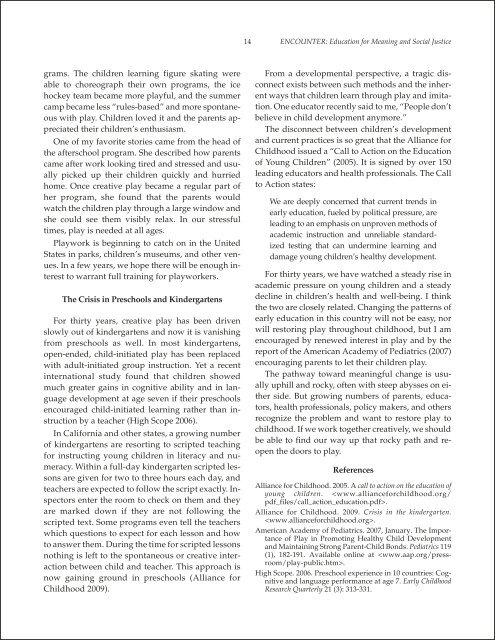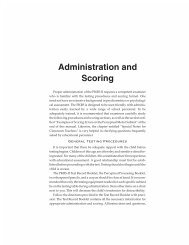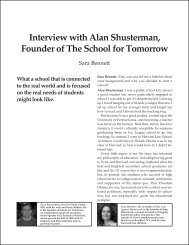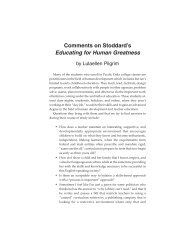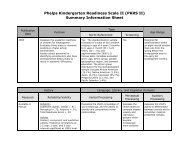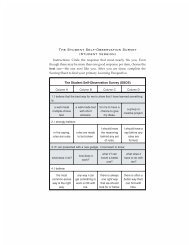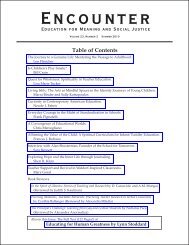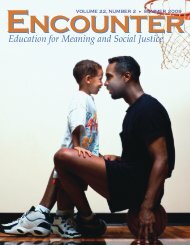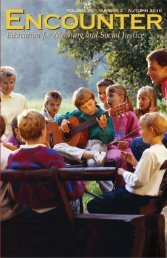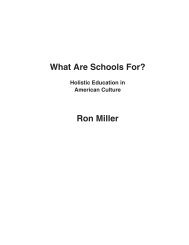Jane Goodall - Great Ideas in Education
Jane Goodall - Great Ideas in Education
Jane Goodall - Great Ideas in Education
Create successful ePaper yourself
Turn your PDF publications into a flip-book with our unique Google optimized e-Paper software.
14 ENCOUNTER: <strong>Education</strong> for Mean<strong>in</strong>g and Social Justice<br />
grams. The children learn<strong>in</strong>g figure skat<strong>in</strong>g were<br />
able to choreograph their own programs, the ice<br />
hockey team became more playful, and the summer<br />
camp became less “rules-based” and more spontaneous<br />
with play. Children loved it and the parents appreciated<br />
their children’s enthusiasm.<br />
One of my favorite stories came from the head of<br />
the afterschool program. She described how parents<br />
came after work look<strong>in</strong>g tired and stressed and usually<br />
picked up their children quickly and hurried<br />
home. Once creative play became a regular part of<br />
her program, she found that the parents would<br />
watch the children play through a large w<strong>in</strong>dow and<br />
she could see them visibly relax. In our stressful<br />
times, play is needed at all ages.<br />
Playwork is beg<strong>in</strong>n<strong>in</strong>g to catch on <strong>in</strong> the United<br />
States <strong>in</strong> parks, children’s museums, and other venues.<br />
In a few years, we hope there will be enough <strong>in</strong>terest<br />
to warrant full tra<strong>in</strong><strong>in</strong>g for playworkers.<br />
The Crisis <strong>in</strong> Preschools and K<strong>in</strong>dergartens<br />
For thirty years, creative play has been driven<br />
slowly out of k<strong>in</strong>dergartens and now it is vanish<strong>in</strong>g<br />
from preschools as well. In most k<strong>in</strong>dergartens,<br />
open-ended, child-<strong>in</strong>itiated play has been replaced<br />
with adult-<strong>in</strong>itiated group <strong>in</strong>struction. Yet a recent<br />
<strong>in</strong>ternational study found that children showed<br />
much greater ga<strong>in</strong>s <strong>in</strong> cognitive ability and <strong>in</strong> language<br />
development at age seven if their preschools<br />
encouraged child-<strong>in</strong>itiated learn<strong>in</strong>g rather than <strong>in</strong>struction<br />
by a teacher (High Scope 2006).<br />
In California and other states, a grow<strong>in</strong>g number<br />
of k<strong>in</strong>dergartens are resort<strong>in</strong>g to scripted teach<strong>in</strong>g<br />
for <strong>in</strong>struct<strong>in</strong>g young children <strong>in</strong> literacy and numeracy.<br />
With<strong>in</strong> a full-day k<strong>in</strong>dergarten scripted lessons<br />
are given for two to three hours each day, and<br />
teachers are expected to follow the script exactly. Inspectors<br />
enter the room to check on them and they<br />
are marked down if they are not follow<strong>in</strong>g the<br />
scripted text. Some programs even tell the teachers<br />
which questions to expect for each lesson and how<br />
to answer them. Dur<strong>in</strong>g the time for scripted lessons<br />
noth<strong>in</strong>g is left to the spontaneous or creative <strong>in</strong>teraction<br />
between child and teacher. This approach is<br />
now ga<strong>in</strong><strong>in</strong>g ground <strong>in</strong> preschools (Alliance for<br />
Childhood 2009).<br />
From a developmental perspective, a tragic disconnect<br />
exists between such methods and the <strong>in</strong>herent<br />
ways that children learn through play and imitation.<br />
One educator recently said to me, “People don’t<br />
believe <strong>in</strong> child development anymore.”<br />
The disconnect between children’s development<br />
and current practices is so great that the Alliance for<br />
Childhood issued a “Call to Action on the <strong>Education</strong><br />
of Young Children” (2005). It is signed by over 150<br />
lead<strong>in</strong>g educators and health professionals. The Call<br />
to Action states:<br />
We are deeply concerned that current trends <strong>in</strong><br />
early education, fueled by political pressure, are<br />
lead<strong>in</strong>g to an emphasis on unproven methods of<br />
academic <strong>in</strong>struction and unreliable standardized<br />
test<strong>in</strong>g that can underm<strong>in</strong>e learn<strong>in</strong>g and<br />
damage young children’s healthy development.<br />
For thirty years, we have watched a steady rise <strong>in</strong><br />
academic pressure on young children and a steady<br />
decl<strong>in</strong>e <strong>in</strong> children’s health and well-be<strong>in</strong>g. I th<strong>in</strong>k<br />
the two are closely related. Chang<strong>in</strong>g the patterns of<br />
early education <strong>in</strong> this country will not be easy, nor<br />
will restor<strong>in</strong>g play throughout childhood, but I am<br />
encouraged by renewed <strong>in</strong>terest <strong>in</strong> play and by the<br />
report of the American Academy of Pediatrics (2007)<br />
encourag<strong>in</strong>g parents to let their children play.<br />
The pathway toward mean<strong>in</strong>gful change is usually<br />
uphill and rocky, often with steep abysses on either<br />
side. But grow<strong>in</strong>g numbers of parents, educators,<br />
health professionals, policy makers, and others<br />
recognize the problem and want to restore play to<br />
childhood. If we work together creatively, we should<br />
be able to f<strong>in</strong>d our way up that rocky path and reopen<br />
the doors to play.<br />
References<br />
Alliance for Childhood. 2005. A call to action on the education of<br />
young children. .<br />
Alliance for Childhood. 2009. Crisis <strong>in</strong> the k<strong>in</strong>dergarten.<br />
.<br />
American Academy of Pediatrics. 2007, January. The Importance<br />
of Play <strong>in</strong> Promot<strong>in</strong>g Healthy Child Development<br />
and Ma<strong>in</strong>ta<strong>in</strong><strong>in</strong>g Strong Parent-Child Bonds. Pediatrics 119<br />
(1), 182-191. Available onl<strong>in</strong>e at .<br />
High Scope. 2006. Preschool experience <strong>in</strong> 10 countries: Cognitive<br />
and language performance at age 7. Early Childhood<br />
Research Quarterly 21 (3): 313-331.


